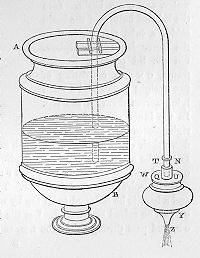No. 5. A vessel for withdrawing Air from a Siphon T0 avoid the necessity of drawing off the water through the mouth, which is only possible in very small siphons, the following contrivance may be used. Take a double tube (fig. 5) one part of which fits into the other, and attach the smaller part to the outer leg of the siphon, so that the discharge may pass through it. Let T N be the smaller tube, and Q U the greater, which must be previously fitted tightly into a vessel, W Y, containing somewhat more water than the siphon will hold, and having an outlet, Z, at the bottom. When it is wished to draw off the water in A B, close the outlet of W Y with the finger, then apply the larger tube Q U to the smaller, and leave the outlet Z free. As the vessel W Y becomes empty the air in the siphon will pass into the exhausted space, and the liquid in A B will follow so as to fill the siphon: then remove the vessel W Y, and let the siphon run.

To act properly the siphon must be perpendicular; and this may be secured by fixing two straight bars to the lip of the vessel A B, and placing the inner leg of the siphon between them so as to touch each of the bars: then fasten a small bar crosswise on each side of the leg of the siphon, so as to touch the former bars within. Thus, if the smaller bars touch the larger, the siphon will neither lean sideways nor forwards, but will hang perpendicularly.
Section 6.